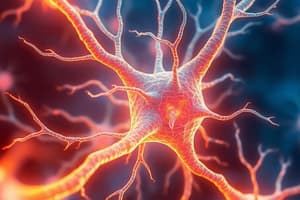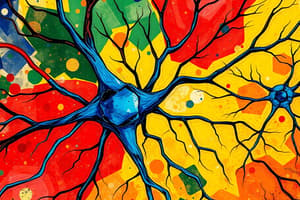Podcast
Questions and Answers
What is the primary role of dendrites in a neuron?
What is the primary role of dendrites in a neuron?
How does the myelin sheath affect neuron function?
How does the myelin sheath affect neuron function?
What is the primary function of glial cells in the nervous system?
What is the primary function of glial cells in the nervous system?
What happens at the synapse?
What happens at the synapse?
Signup and view all the answers
Which of the following is a consequence of myelin damage?
Which of the following is a consequence of myelin damage?
Signup and view all the answers
What is the primary charge of a neuron at rest?
What is the primary charge of a neuron at rest?
Signup and view all the answers
What is the relationship between the size of a graded potential and the size of the stimulus?
What is the relationship between the size of a graded potential and the size of the stimulus?
Signup and view all the answers
Which structure in a neuron is primarily responsible for receiving signals from other neurons?
Which structure in a neuron is primarily responsible for receiving signals from other neurons?
Signup and view all the answers
How are graded potentials generated within a neuron?
How are graded potentials generated within a neuron?
Signup and view all the answers
What maintains the resting potential of a neuron?
What maintains the resting potential of a neuron?
Signup and view all the answers
Study Notes
Building Blocks of the Nervous System
- Neurons are specialized cells for communicating information; they are the basic building blocks of the nervous system
- Neurons have three main parts: dendrites, axons, and a cell body
- Dendrites receive information and carry it toward the cell body
- Axons carry information away from the cell body
- The axon may be covered in myelin, a fatty sheath, that speeds up signal transmission
- Gaps in the myelin sheath are called Nodes of Ranvier
- Axon terminals are at the end of axons and contain neurotransmitters
- Glial cells surround, support, and protect neurons and form the myelin sheath
- Glial cells outnumber neurons 10 to 1
- Glial cells perform basic housekeeping functions, including cleaning up cellular debris
- The blood-brain barrier prevents certain substances from reaching the brain
- Synapse is a region where axon terminals of a neuron approach other cells (other neurons, muscle cells, or gland cells)
- Synapses are where nerve cells communicate with each other or other cells of various types
- Neurons come in several different types and sizes, with varying shapes, reflecting their diverse roles in the nervous system.
Neurons: Their Basic Structure
- Neurons are tremendously varied in appearance
- Most neurons consist of three basic parts: a cell body, an axon, and dendrites
- Dendrites carry information towards the cell body
- Axons carry information away from the cell body
- The axon may be covered by a fatty substance called myelin sheath.
- The myelin sheath is interrupted by gaps called Nodes of Ranvier
- Axons that are covered by myelin transmit information faster than ones that are not
- Damage to the myelin sheath affects synaptic transmission, a key factor in diseases like Multiple Sclerosis (MS)
- Axons and dendrites come together at the terminals in a process called a synapse
- The synapse is the gap between the cells to allow for communication
- The myelin sheath and gaps play an important role in neuron's ability to transmit information
- Axon terminals contain neurotransmitters, which are substances that transmit signals between neurons or between neurons and other cells.
- The synapse is where neurotransmitters are released to communicate with other cells.
Studying That Suits You
Use AI to generate personalized quizzes and flashcards to suit your learning preferences.
Description
Explore the fundamental components of the nervous system with this quiz focused on neurons. Learn about the structure and functions of dendrites, axons, and glial cells, as well as important concepts like synapses and the blood-brain barrier. Test your knowledge on how these building blocks interact to facilitate communication within the body.




